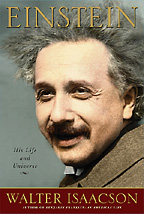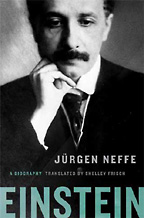Two biographies, with two unique approaches, chronicle the humanness and historical context of his remarkable life.


Einstein
His Life and UniverseBy Walter Isaacson
Simon & Schuster. 704 pp. $32
Einstein
A Biography By Jürgen Neffe
Translated by Shelley Frisch
Farrar, Straus & Giroux. 480 pp. $30
Reviewed by Richard Di Dio
Philadelphia Inquirer - Sunday, May 20, 2007
Just two years ago, the world celebrated the 100th anniversary of Albert Einstein's annus mirabilis. For many learning his story for the first time, the image that emerged was of a saintly savant whose physics grand slam was announced on a flickering newsreel . . .
Bern, Switzerland, 1905. At age 26, Albert Einstein, junior patent clerk, has published four breakthrough papers in less than a year, each of breathtaking originality, each potentially Nobel Prize-worthy. Einstein's results help verify the existence of atoms, explain the quantum nature of light, and supplant Newton's dynamics with the Special Theory of Relativity.
The incredible story of 1905 should only whet one's appetite for more about Einstein, whose celebrity and world influence justifiably made him Time magazine's Person of the Century. His life was marked with unimaginable successes and disappointing failures in many areas besides science - including, as frankly portrayed in two important new biographies, matters of love and lust.
The difficulty all Einstein biographers face is how to explain his superhuman achievements in human terms we can all understand. Remarkably, Walter Isaacson in Einstein: His Life and Universe and Jürgen Neffe in Einstein: A Biography do just that. In presenting Einstein's story fully illuminated by the contingencies of world wars, anti-Semitism and fractured family, both authors give the reader a clearer view of the events that shaped Einstein's trajectory from opinionated student to history's first "most famous person in the world."
Isaacson and Neffe quote extensively from materials provided by the Einstein Papers Project - an estimated 50-year plan to document the roughly 80,000 items Einstein left behind in the form of scribbled equations, letters, manuscripts and notebooks. The archives contain everything from scrap pages chronicling Einstein's early abortive efforts in forming his theory of General Relativity to silly, puppy-love poems (doggerel, according to Neffe) written for the many women in his life.
With 10 volumes already released, Isaacson and Neffe are the first to assimilate the material into a full account of Einstein's life. Nevertheless, though they start with the same facts, they could not be more different in their narrative approach.
Isaacson, the author of Benjamin Franklin: An American Life, masterly recounts Einstein's life chronologically, from his early education to Nobel Prize fame and ultimate role as world's conscience promoting social justice and individual liberty. His account of Einstein's exhausting race to the General Theory of Relativity in the midst of the breakup of his marriage and the start of World War I is more riveting than fiction can ever be. Einstein's reluctant change from his pacifist stance, culminating in his famous letter of 1939 to FDR warning of the potential for an atomic bomb, is also covered in depth.
Neffe, a doctorate biochemist and journalist, tells Einstein's story as a life defined by broad, overlapping themes. Starting with the pathologist who stole Einstein's brain in 1955 (ostensibly for research into the physical basis of genius), Neffe's work is a psychological-historical study, with chapters that focus on Einstein as scientist, careerist, philosopher, statesman, Jew, and - what are sure to be the most controversial aspects - parent and lover.
Most readers will be shocked to learn of Einstein's incredibly harsh treatment of his first wife, Mileva, and their children. He never saw their first child, Lieserl, who was born out of wedlock and presumably adopted. Neffe's chapter on Einstein's relationships with his two sons, titled "Dear Boys . . . Your Papa," is especially heartbreaking. The younger son, Eduard - a schizophrenic - died a lonely figure in a psychiatric hospital, not visited by his father for decades.
As much as the personal life of Einstein is essential for understanding the man, it is still his special approach to physics that defines him, and neither Isaacson nor Neffe skimps here. Their descriptions of such oddities as "4-dimensional space-time" and "generally covariant tensors" are very imaginative, and nonscience readers should come away with a good understanding of the unusual implements in Einstein's mathematical toolbox.
There is much to praise in both of these biographies. For its sheer completeness and clarity, I recommend Isaacson's work for all who know little about Einstein beyond E = mc2. For a unique presentation that provides a deeper analysis of the parts of his life that have been hidden until now - from earliest scientific and philosophical influences to his affair with a Russian spy - Neffe's work is essential.
Ironically, the humanness revealed in both books makes Einstein's scientific breakthroughs all the more improbable. It may be impossible to understand the cause of genius, but it is easy to understand the effect this particular genius had on the world. According to Max Born, Nobel physicist and Einstein contemporary:
People who had lost all faith in higher values during those years of misery, murderous warfare, lies and slander saw their hopes revived by the appearance of a simple, modest man who calmly contemplated the nature of space, time and matter in the thick of these hellish circumstances and helped lift the veil of mystery surrounding creation.
These new biographies lift the veil on Einstein, revealing the complexity behind the simplicity, and the sometimes immodest man behind the modesty. In so doing, they paint a very human portrait of a person who, though by no means a saint, led a life that was indeed miraculous.
Richard Di Dio teaches physics and mathematics at La Salle University.
http://www.philly.com